- Home
- German Food Guide
- German Brötchen Recipe
Heidi's German Brötchen Recipe: Crusty Bread Rolls
By: Gerhild Fulson / Using her extensive experience and cultural knowledge, Oma Gerhild provides trusted, authentic, and easy-to-follow German recipes both here and in her many cookbooks.
Freshly baked breads, rolls, and pastries, oh my! Did you know there are more bakeries and varieties of bread in Germany than in any other country?
Yes, bread is popular all over Germany with seemingly a bakery on every corner. And the state of Schleswig-Holstein is no different. This German bread rolls recipe is from my dear friend, Heidi, who hails from this region. Hubby and I frequently visited her family in the Bredstedt/Husum area and we so enjoyed our trips to the bakeries in the mornings to get our freshly baked Brötchen (also called Rundstück in this part of the country).
It's actually one of the best things about living in, or visiting, Germany. Going to the local bakery, usually just around the corner, for a delicious assortment of freshly baked breads, rolls, and pastries is just wunderbar. Ask any German what they miss most while traveling or living abroad and the first thing they're likely to say is, "The bread!"
You can see that bread plays a significant role in German culture. In fact, Germany is considered the bread capital of the world with now more than 3,200 officially recognized types of breads in the country! Among all the different types of breads are Brötchen. Brötchen is a German word that means small bread. These are delicious rolls that are soft on the inside and crusty on the outside. Yum!
Different types of German Brötchen
These tasty German bread rolls come in all sorts of varieties. In fact, it's claimed that there are over a thousand different types of this little bread throughout the different regions of Germany.
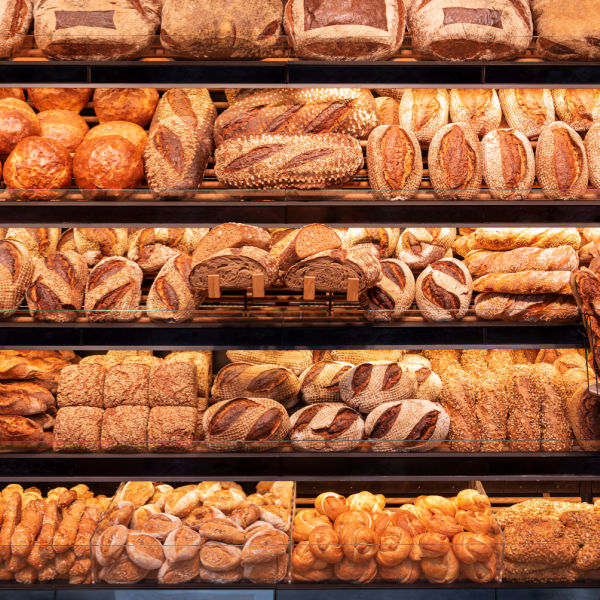
Here are some, to name a few:
- Sesambrötchen (sesame rolls) - These rolls are coated with sesame seeds, which give the rolls a subtle nutty flavor as well as a slightly crunchy texture.
- Mohnbrötchen (poppy seed rolls) - These rolls are coated in poppy seeds, giving them a slightly sweet and nutty flavor. The seeds also add a nice little crunchy texture.
- Sonnenblumenkernbrötchen (sunflower seed rolls) - These rolls are topped with sunflower seeds, giving the rolls a mild nutty, earthy flavor. And, of course, that added crunch.
- Vollkornbrötchen (whole grain rolls) - These rolls are made with whole grain flour, giving them a denser texture with a nutty, earthy flavor. They are also darker in appearance and are often topped with sunflower or pumpkin seeds for added crunch.
- Käsebrötchen (cheese rolls) - These flavorful rolls are both filled and covered with cheese, typically Emmental or Gouda. They are perfect for a savory breakfast, as a snack throughout the day, or as a side dish to soups or salads.
- Laugenbrötchen (pretzel rolls) - These rolls are made with a dough that has been boiled in a lye solution before baking. This process gives them a slightly chewy texture and that yummy pretzel flavor. They are often topped with coarse salt and are delicious served warm with mustard.
- Rosinenbrötchen (raisin rolls) - These delicious rolls are filled with raisins and have a sweet and slightly fruity flavor. They are so good as a breakfast treat or as a dessert.
How to measure flour properly for best results
In classic German baking, dry ingredients are always weighed rather than measured by volume. This is the most accurate way to measure, which results in the best breads, cakes, pastries, etc. It can make all the difference in rolls that are just right and rolls that are too dry.
This is especially true of flour. Measuring flour using a measuring cup can be wildly inaccurate. Try this little experiment to see what I mean:
Use a measuring cup to scoop out flour straight out of the bag and level it off.
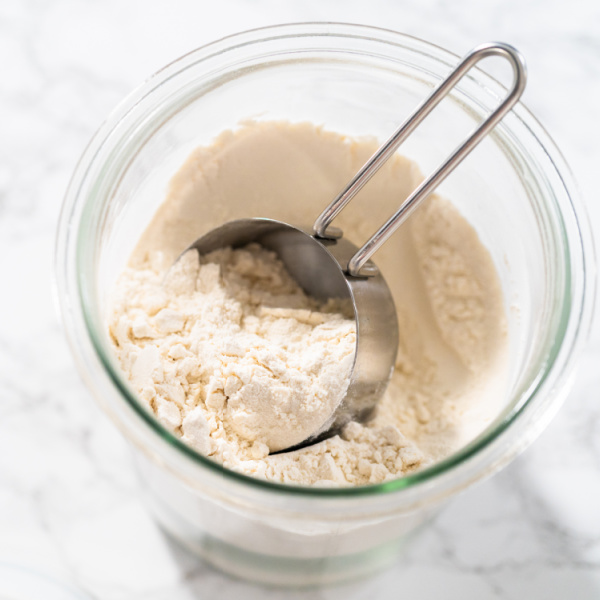
Next, fluff up the flour in the bag with a spoon or fork. With a spoon, scoop up the fluffed-up flour into a measuring cup until it overflows and level it off with the back of knife. Now weigh them and see the difference! You'll find that you end up with more flour when scooping it straight from the bag than if you fluff it up first before spooning it into the cup.
So if you can, get yourself a digital scale. One cup of flour weighs 130 grams. You will never go wrong weighing the flour since a gram is a gram, whether you scoop or spoon the flour, or if the flour is sifted (which also affects the volume).
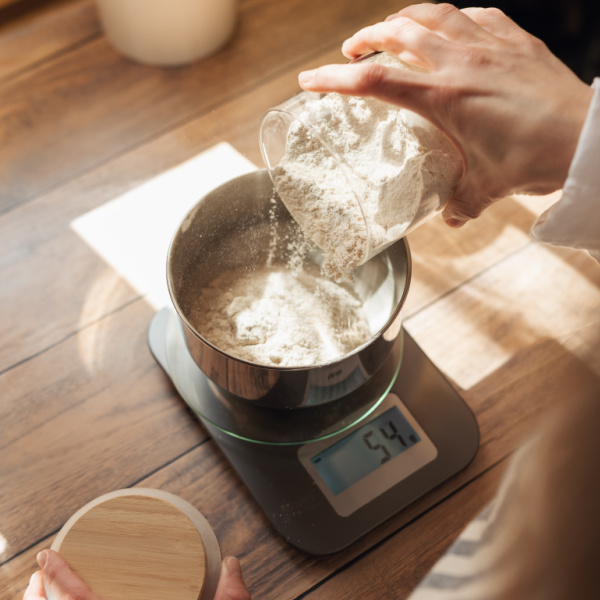
If you do not have access to a scale, the most accurate way to measure flour is the fluff-and-spoon method mentioned above.
How to make Heidi's Brotchen recipe
This is such a simple Brötchen recipe with simple ingredients that you'll want to make these delicious German rolls over and over again. You'll find there's nothing quite like fresh Brötchen!
These are quick to make, but you do have to account for the time it takes for the dough to rise.
Start with placing 3½ cups of flour and 1 teaspoon salt into the large mixing bowl of an electric mixer. Then stir 2¼ teaspoons instant dry yeast into 1¼ cups lukewarm water and pour it over the flour.
Use the dough hook of your electric mixer to slowly mix all of the ingredients together until it forms a soft dough that holds together, adding a little extra flour at a time, if necessary.
Increase the speed and knead the dough for about 10 minutes until it becomes elastic and no longer sticks to the bowl.
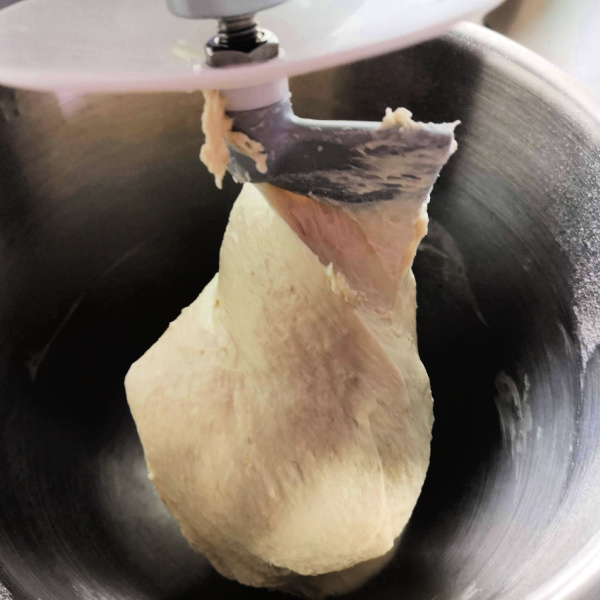
Add a little flour to your work surface. Remove the dough from the bowl and knead it briefly by hand.
Oil the bowl and place the dough back in it. Cover the bowl with a clean kitchen towel and let it rest in a warm spot for 1 hour while the dough rises.
Gently punch down the dough to deflate it. Do not knead it again.
Preheat your oven to 465 degrees F.
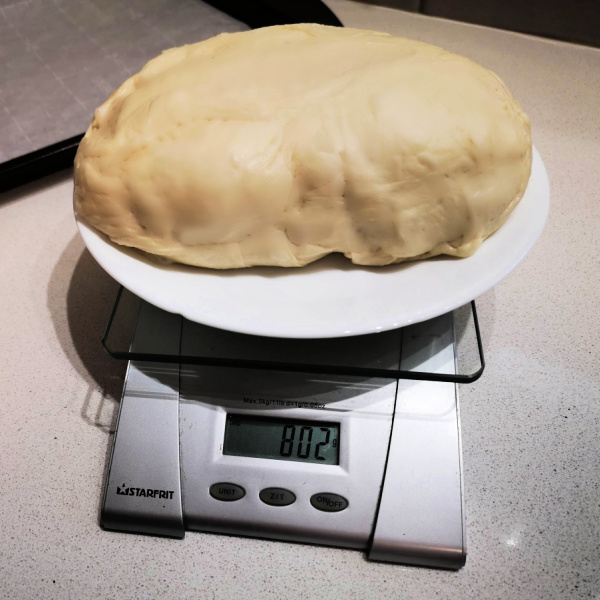
To make it easier to divide the dough into equal parts, weigh the dough first.
It usually weighs around 800 grams, but this depends on the moisture content of your flour.
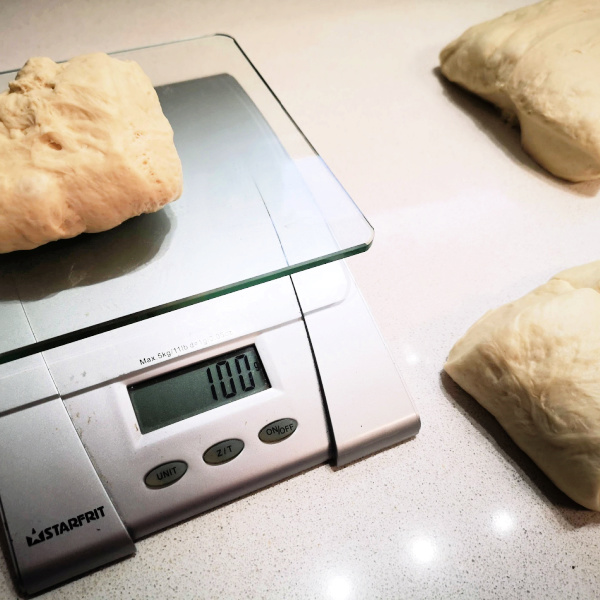
Divide the dough into 8 equal pieces—in my case, around 100 grams each—and shape into oval rolls. Place them on a baking sheet lined with parchment paper.
Score each one deeply with a razor blade or sharp knife.
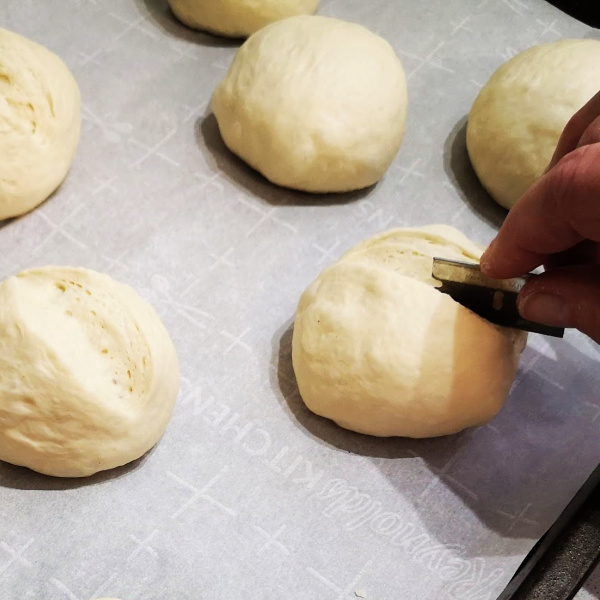
These rolls rise so quickly, that the moment I had cut once, I quickly went back and cut a bit more.
Cover the rolls with a clean kitchen towel and let them rise for ½ an hour.
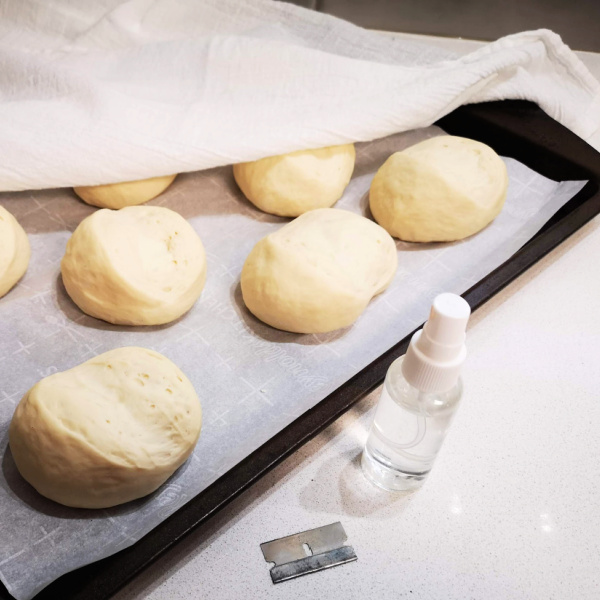
Score them again deeply and spray them lightly with water from a spray bottle. Spraying the unbaked rolls with water is what gives them that crispy exterior.
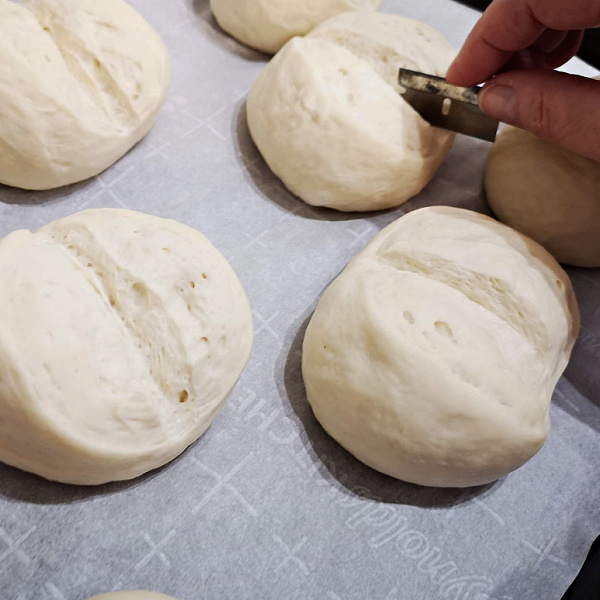
Bake in the preheated oven for 10 minutes.
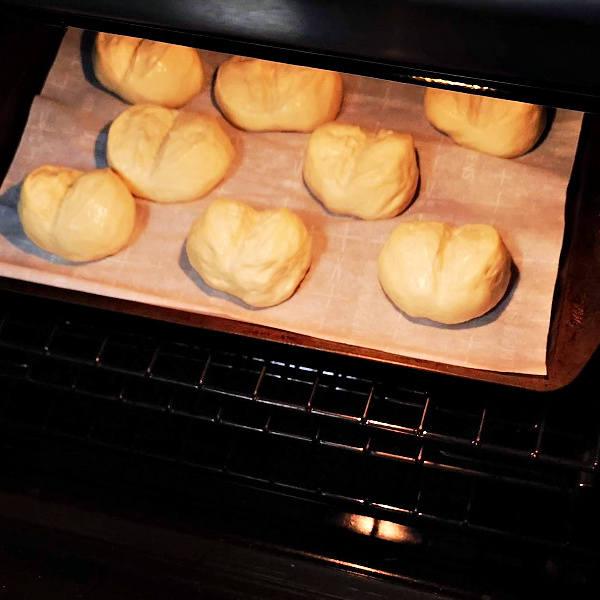
Take them from the oven briefly to spray the rolls with water and lower the temperature to 410 degrees F.
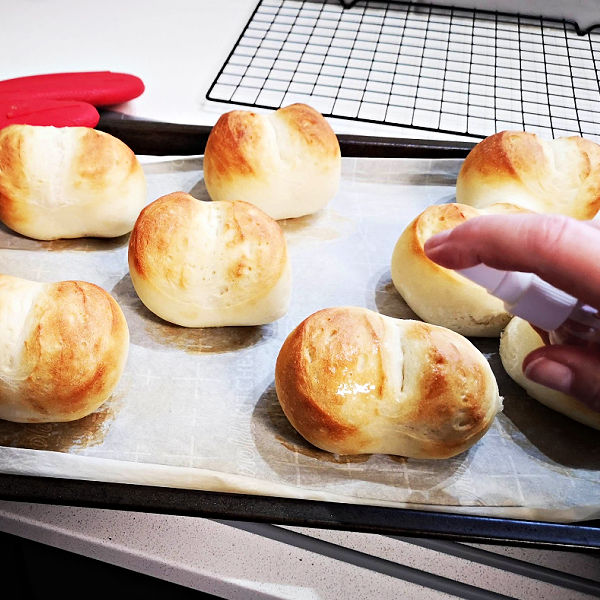
Bake for another 10 minutes.
Remove the hot baking sheet from the oven and let them cool slightly.
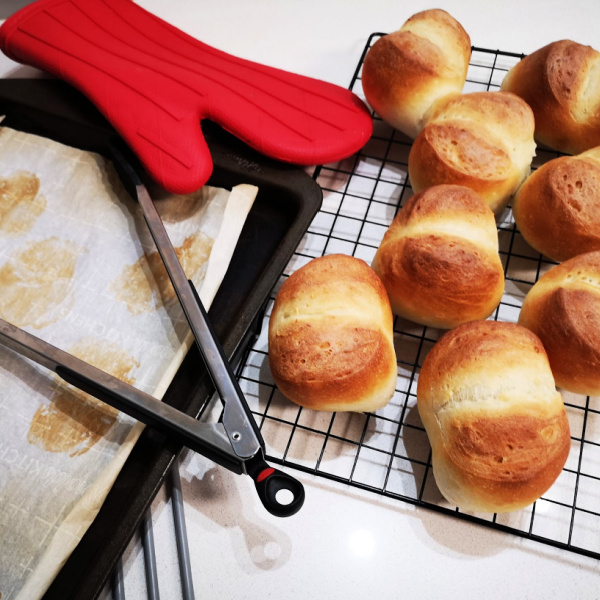
Enjoy your German Brotchen warm or at room temperature.
These also freeze well and can be reheated to serve.
What to serve with these deliciously crusty German bread rolls
Serve fresh bread rolls along with sweet jams, savory spreads, cold cuts, and cheeses like Gouda or Emmental for a delicious and traditional German breakfast.
Make a fish sandwich. Yep, that's right! With its proximity to the North Sea, eating seafood on bread rolls is very traditional in the state of Schleswig-Holstein, as well as in the other coastal regions of Northern Germany.
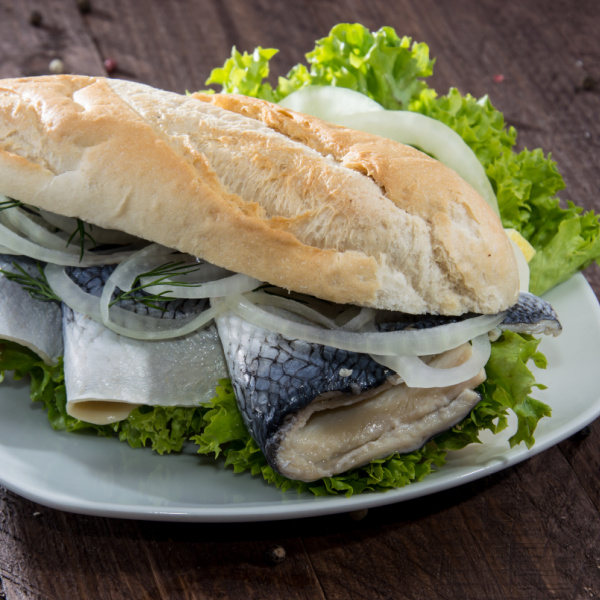
In fact, these two seafood sandwiches listed below are commonly served at fast-food stands in this part of the country.
- Krabbenbrötchen ("crab" roll): This is a sandwich made with Nordseekrabben (literally, North Sea "crabs"), which are actually tiny shrimp, that are mixed with mayonnaise. Other toppings and seasonings can include lettuce, lemon juice, fresh herbs, salt, and pepper.
- Fischbrötchen (fish roll): This sandwich can be made with a variety of fish, such as herring, sprat, cod, salmon, sole, and mackerel. Traditional toppings include white onions, pickles, horseradish, lettuce, and remoulade. (Remoulade, interestingly enough, is a traditional French sauce made with mayonnaise, capers, pickles, and fresh herbs.)
Brötchen are also delicious served as a side to German soups, stews, and meat and gravy dishes; whether you dunk them or use them to mop up the delicious broth, sauce, or gravy, they are a wonderful side dish.
More recipes from Schleswig-Holstein
Want more recipes from this part of Germany? Check out more of Heidi's recipes:
- Marinated Roast Potato Recipe
- Easy Apple Pudding Cake
- Rhubarb Pudding Recipe
- Easy German Raspberry Cake Without Flour
Now, time to make some bread rolls?
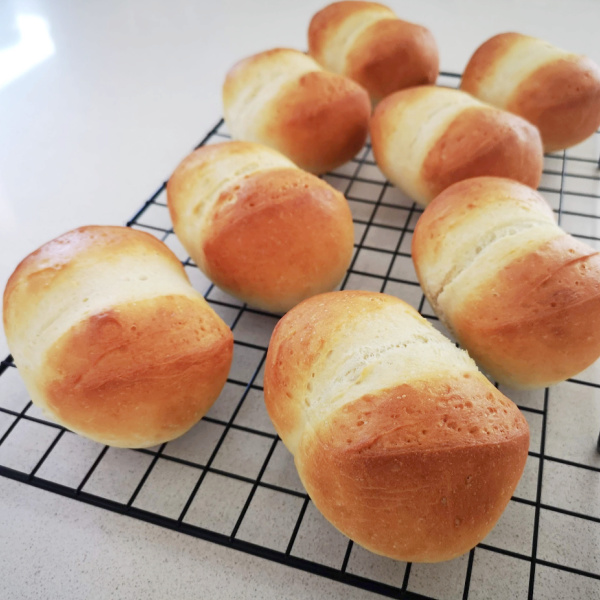
Heidi's German Brötchen Recipe
When traveling to any part of Germany, at least one visit to a bakery is a must. Making these bread rolls fresh at home is the next best thing!
Prep Time2 hours 10 minutes |
Bake Time20 minutes |
Total Time2 hours 30 minutes |
Servings:
Makes 8 buns
Ingredients:
- 4 cups (520 grams) bread flour (or all-purpose), divided
- 1 teaspoon (6 grams) salt
- 2¼ teaspoons (7 grams) instant yeast
- 1¼ cups (300 milliliters) lukewarm water
- water in a spray bottle
Instructions:
- Put 3½ cups of the flour (455 grams) and the salt into the large bowl of an electric mixer.
- Stir the yeast into the warm water and pour the mixture over the flour.
- Using a dough hook, mix the wet and dry ingredients together slowly until the dough holds together, adding the remaining flour, one tablespoon at a time, as needed. Increase the speed and knead for 10 minutes until the dough is elastic and doesn’t stick to the side of the bowl.
- Remove the smooth dough from the bowl and knead it briefly by hand on a lightly floured surface. Oil the bowl and place dough back in the bowl. Cover the bowl with a kitchen towel and let the dough rest for 1 hour in a warm place.
- Deflate the dough by punching it down gently, but do not knead it again.
- Preheat the oven to 465°F (240 degrees C).
- Divide dough into 8 equal parts to form buns, approximately 3.5 ounces (100 grams) each. Place each piece of dough on a parchment paper-lined baking tray and score deeply, using a razor blade or sharp knife.
- Cover the rolls with a clean kitchen towel and let rise for ½ hour.
- Score the risen rolls deeply again and spray lightly with water. Bake in the preheated oven for 10 minutes.
- Lower the temperature to 410°F (210 degrees C) and spray the rolls with water again. Bake another 10 minutes.
- Remove when done and let them cool slightly. They can be eaten warm or at room temperature.
Notes/Hints:
- Weighing the flour is best. If you don't have a scale, be sure to fluff up the flour before spooning it into your measuring cup, then level the flour with the back of a knife.
- Try spraying the rolls with salt water; add about 2 teaspoons salt to 2 tablespoons water.
- Right after the rolls are first sprayed with water, sprinkle with different seeds, such as poppy seeds, chia seeds, sesame seeds, sunflower seeds, or pumpkin seeds.
- Try substituting whole wheat flour for the all-purpose flour.
* * * * *
Unless otherwise noted recipe, images and content © Just like Oma | tourmygermany.com
Heidi's German Brötchen Recipe: Crusty Bread Rolls
By Oma Gerhild Fulson
Experience a taste of Germany with Heidi's German Brötchen recipe. Her golden-brown, crusty rolls are reminiscent not only of Schleswig-Holstein, but of all of Germany!
Ingredients: bread flour, salt, instant yeast, water
For the full recipe, scroll up ...

















